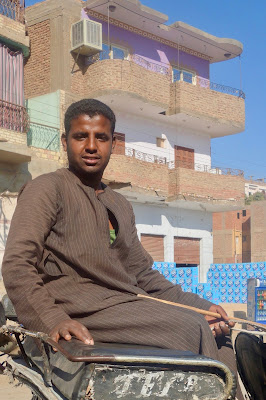A horse carriage took us to the main attraction bright and early.
Ahmed told us to withhold our tip until we returned if we wanted transportation back to the St. George. "Remember your number!" he said.
Horus, the god of the sky, is usually depicted as a falcon.
Kwesi (which means Sunday in Ghana where people often name their children after the days of the week) and Nora listened more attentively to Ahmed than many in our group. He explained that Egyptians built the temple in the Ptolemaic period, after they had been conquered by Alexander the Great. Realizing their gods weren't so different from those of the Greeks, Alex shrewdly allowed the natives to worship whoever they liked. He added his stamp to temples constructed during his reign with an occasional doric column.
The Christians were less tolerant after eventually coming to power. They obliterated the faces of the pagan gods. Here, Horus stands atop a hippo, a symbol of evil. Then, as now, hippos were the most dangerous animal in Africa. Who knew their range once included the Nile?
Famous for what now is known as "aromatherapy," ancient Egyptians priests recorded the recipes for their potions in one of the temple's rooms.
Enough lessons. Ahmed finally released us for photos. He was hoarse from talking, and I was chomping at the bit.
Number 150 awaited us in the parking lot.
Now that the streets had come to life, our return trip reminded me of the pedicab ride we'd taken in Jaipur.
Even in Edfu, the citizens knows what butters their country's bread!
Before disembarking at the St. George, Sari took the reins for a photo op.




















No comments:
Post a Comment